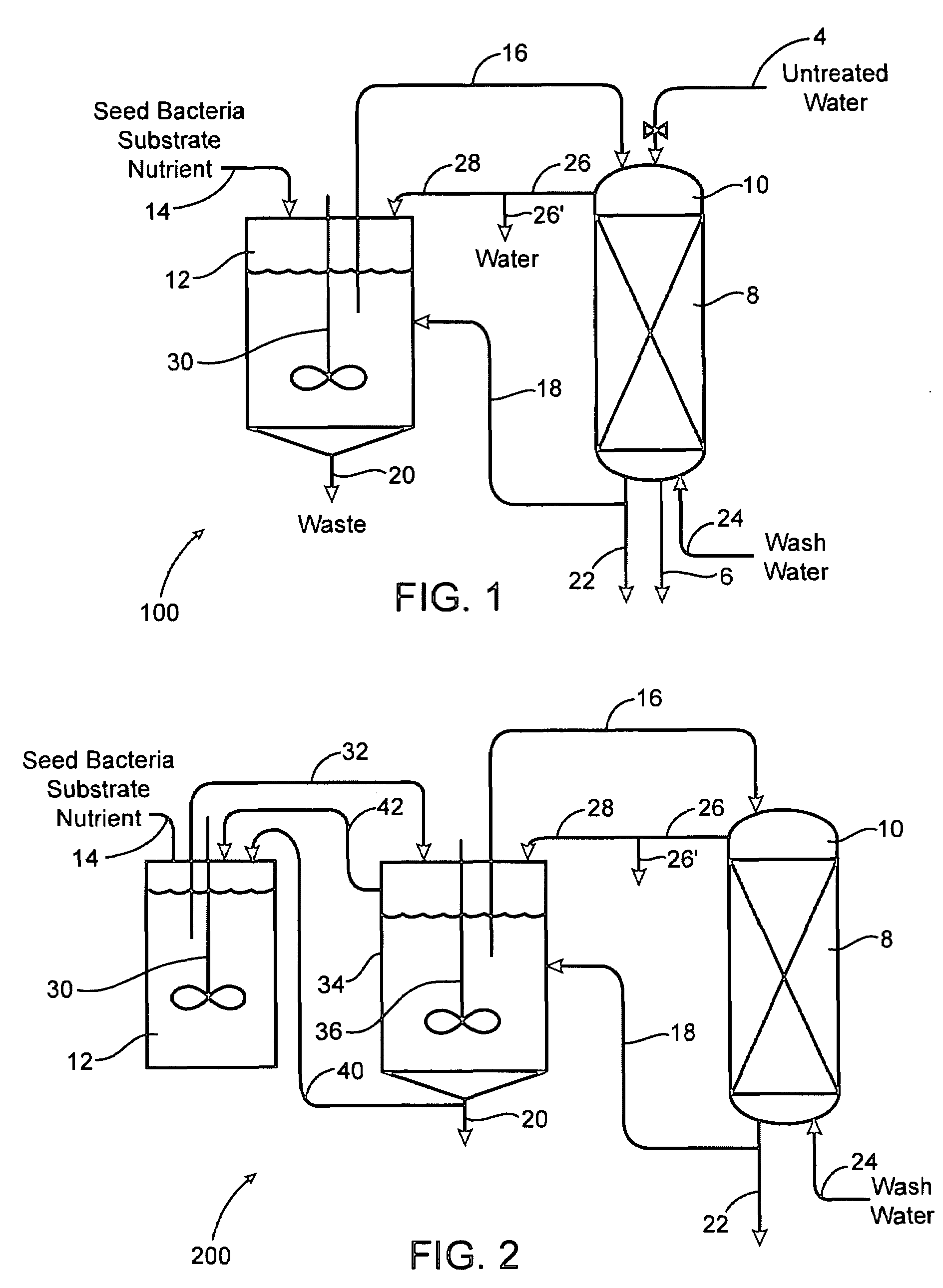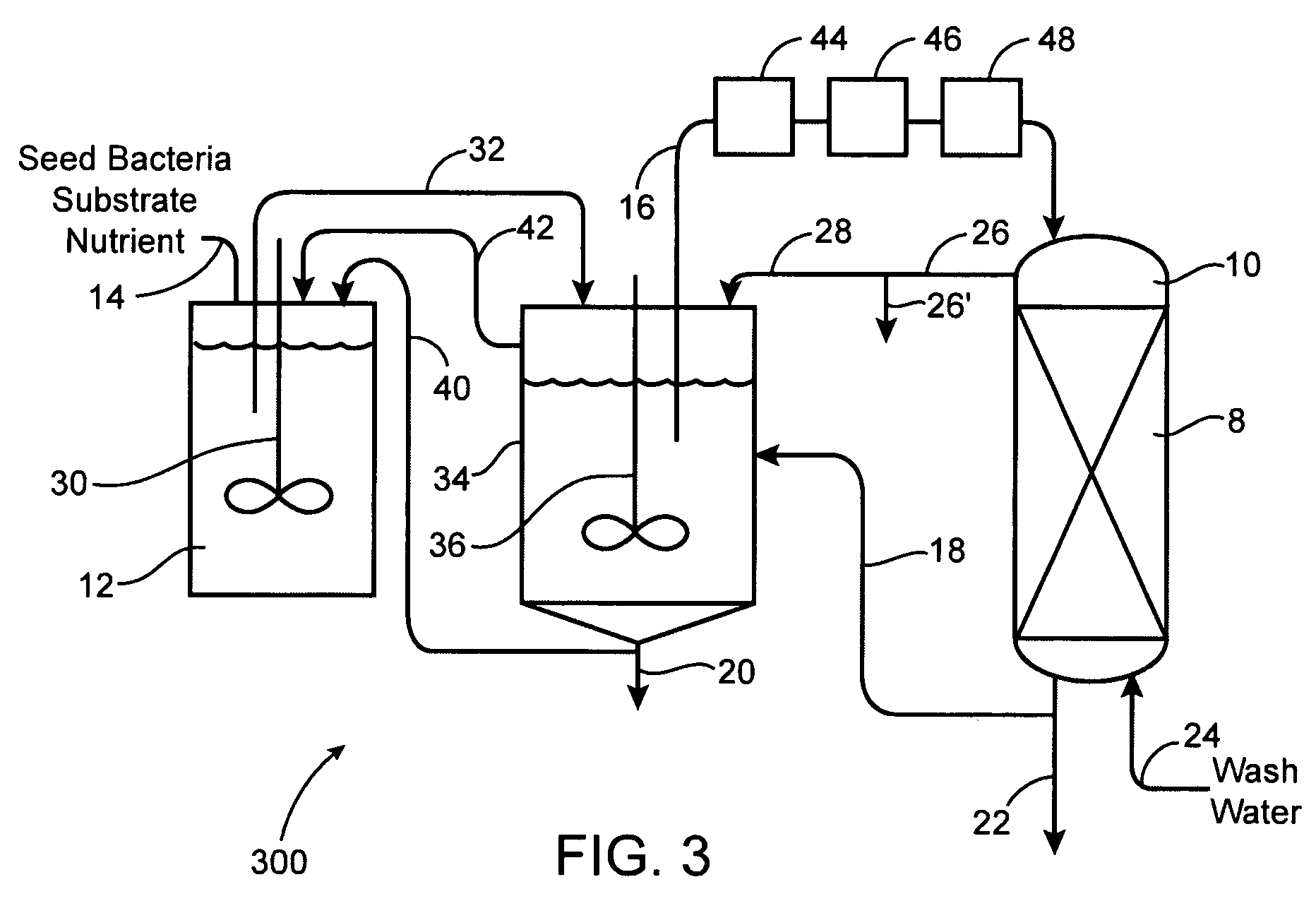Bio degradation of oxyanions such as perchlorate on ion exchange resins
a technology of oxyanions and resins, applied in the field of water treatment, can solve the problems of perchlorate contamination of surface water and ground water supplies, state of the art practice does not provide a practical and convenient method for resin regeneration, and the end product is difficult to deal with perchlorate load
- Summary
- Abstract
- Description
- Claims
- Application Information
AI Technical Summary
Benefits of technology
Problems solved by technology
Method used
Image
Examples
example 1
Bench Scale Tests
[0103]The following is a description of bench scale tests that show perchlorate can be degraded while it is adsorbed on an ion exchange resin.
[0104]Anaerobic digestion was demonstrated to be very efficient in degrading perchlorate that has been adsorbed onto A520E resin. The resin was saturated with a perchlorate solution. A sample of conventional sewage sludge was obtained and grown up under anaerobic conditions with added lower alcohol nutrient in an aqueous medium. A sample of this suspension of microorganisms was placed in a bioreactor. The saturated resin sample was placed in a pair of perforated holders to allow the suspension of microorganisms to contact the resin. The reactor was purged with nitrogen and maintained under anaerobic conditions. The suspension and the loaded resin were allowed to remain in contact for two weeks.
[0105]One of the two samples of the resin was removed from the reactor after a period of two weeks and bacterial sludge was removed by ...
example 2
Effect of Agitation and Flow Systems
[0109]As shown in Example 1, at zero flow rate or very low rates only about 40% of the perchlorate can be removed regardless of time (days) in the reactor. However, with agitation or with a high flow rate, such as flow system space velocities of from about 0.1 to about 10 v / (v×hrs)Vv 100% regeneration can be achieved using a suspension of microorganisms in times as short as about 3 days.
example 3
Comparison of Use of Slurry and Supernatant Fluid Microorganism Products
[0110]In order to investigate the effect of pre-sedimentation on the bio-regeneration efficiency, two ion exchange columns loaded with perchlorate-loaded A-520-E resin were connected to the bio-regeneration systems, with and without pre-sedimentation. The presedimentation zone was as set forth in FIG. 2. A sewage sludge source of microorganisms as used in Example 1 was used. One column (A) was fed supernatant produced in a sedimentation basin (working volume 2.6 L) which was placed between the bioreactor and Column A. Pickets, which rotated at 0.6-0.7 rpm, were installed to prevent the bridging of sludge particles and to accelerate the release of biogas. The second column, Column B was fed anaerobic sludge. Due to the high concentration of suspended solids (SS), it was not easy to pump anaerobic sludge to Column B continuously. So, Column B flow to was operated intermittently (10 to 20 min per day) Column B coul...
PUM
| Property | Measurement | Unit |
|---|---|---|
| period of time | aaaaa | aaaaa |
| period of time | aaaaa | aaaaa |
| period of time | aaaaa | aaaaa |
Abstract
Description
Claims
Application Information
 Login to View More
Login to View More - R&D
- Intellectual Property
- Life Sciences
- Materials
- Tech Scout
- Unparalleled Data Quality
- Higher Quality Content
- 60% Fewer Hallucinations
Browse by: Latest US Patents, China's latest patents, Technical Efficacy Thesaurus, Application Domain, Technology Topic, Popular Technical Reports.
© 2025 PatSnap. All rights reserved.Legal|Privacy policy|Modern Slavery Act Transparency Statement|Sitemap|About US| Contact US: help@patsnap.com



